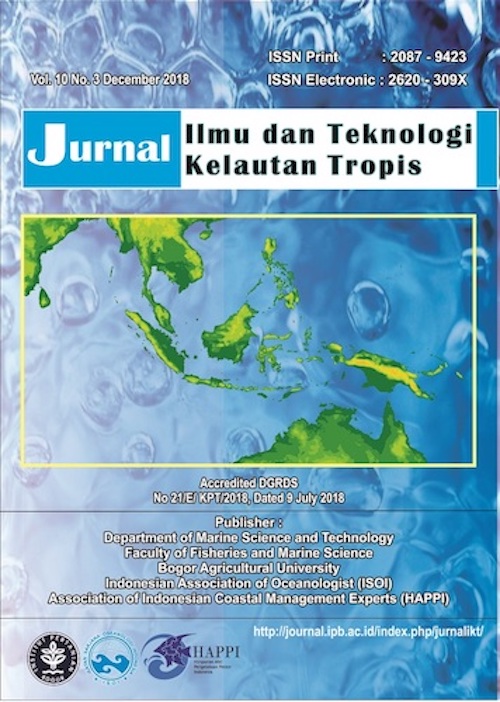PENGARUH JUMLAH TITIK AERASI PADA BUDIDAYA UDANG VANAME, Litopenaeus vannamei
Abstract
ABSTRAK
Salah satu upaya untuk meningkatkan oksigen terlarut di perairan tambak dapat dilakukan melalui sistem aerasi dasar. Jumlah titik aerasi dasar diduga mempengaruhi kelarutan oksigen dan berdampak pada performa budidaya udang di tambak. Penelitian ini menggunakan dua petak tambak beton masing-masing 1.000 m2 dilengkapi dengan sistem aerasi dasar yang terbuat dari rubber diffuser sepanjang 100 cm, berjumlah 140 buah (Perlakuan A) dan 70 buah (Perlakuan B). Benur udang vaname PL-9 ditebar dengan padat penebaran 600 ekor/m2 dan dipelihara selama 70 hari. Perlakuan A menghasilkan kelarutan oksigen 3,04-10,36 (6,60±1,07) mg/L lebih tinggi dibandingkan perlakuan B dengan kisaran oksigen terlarut 2,77-7,92 (6,08±0,95) mg/L. Sebaliknya parameter nitrit, total nitrogen, phosphat dan bahan organik terlarut lebih rendah di perlakuan A. Produksi, sintasan, dan rasio konversi pakan pada perlakuan A masing-masing 5.620 kg, 93,6% dan 1,12 dan perlakuan B masing-masing 4.000 kg, 80,7% dan 1,51. Perlakuan A menghasilkan performa budidaya lebih baik dibandingkan perlakuan B. Untuk meningkatkan pasokan oksigen terlarut di tambak dapat digunakan rubber diffuser yang dihubungkan dengan blower.
ABSTRACT
One effort to increase dissolved oxygen concentration in pond waters is by applying bottom aeration system. The number of aeration point in the pond bottom allegedly affects oxygen solubility and shrimp farming performance. This study utilized two concreted ponds of 1000 m2 each equipped with two bottom aeration systems built by 100 cm long of rubber diffuser, totaling 140 pieces (Treatment A) and 70 pieces (Treatment B). The PL-9 of L. vannamei were stocked with density of 600 ind/m2 and reared for 70 days. Treatment A resulted dissolved oxygen of 3.04-10.36 (6.60±1.07) mg/L which were higher than Treatment B where the range of dissolved oxygen were 2.77-7.92 (6.08±0.95) mg/L. In contrast, nitrite, total nitrogen, phosphate and dissolved organic matter were lower within treatment A. Shrimp production, survival rate and feed conversion ratio in Treatment A were5, 620 kg, 93.6% and 1.12, respectively; whereas in treatment B were 4,000 kg, 80.7% and 1.51. Treatment A resulted in a better the L. vannamei farming compared to treatment B. To increase the supply of dissolved oxygen in the pond, a rubber diffuser can be used which is connected to a blower.Authors
This work is licensed under a Creative Commons Attribution 4.0 International License.
Jurnal Ilmu dan Teknologi Kelautan Tropis i is an open-access journal, meaning that all content is freely available without charge to the user or their institution. Users are allowed to read, download, copy, distribute, print, search, or link to the full texts of the articles in this journal without needing to request prior permission from the publisher or the author.
All articles published by Jurnal Ilmu dan Teknologi Kelautan Tropis are licensed under the Creative Commons Attribution 4.0 International License. This allows for unrestricted use, distribution, and reproduction in any medium, provided proper credit is given to the original authors.
Authors submitting manuscripts should understand and agree that the copyright of published manuscripts is retained by the authors. Copyright encompasses the exclusive rights of authors to reproduce, distribute, and sell any part of the journal articles in all forms and media. Reproduction of any part of this journal, its storage in databases, and its transmission by any form or media is allowed without written permission from Jurnal Ilmu dan Teknologi Kelautan Tropis.


